Dan Ou
TaoSearchEmb: A Multi-Objective Reinforcement Learning Framework for Dense Retrieval in Taobao Search
Nov 17, 2025Abstract:Dense retrieval, as the core component of e-commerce search engines, maps user queries and items into a unified semantic space through pre-trained embedding models to enable large-scale real-time semantic retrieval. Despite the rapid advancement of LLMs gradually replacing traditional BERT architectures for embedding, their training paradigms still adhere to BERT-like supervised fine-tuning and hard negative mining strategies. This approach relies on complex offline hard negative sample construction pipelines, which constrain model iteration efficiency and hinder the evolutionary potential of semantic representation capabilities. Besides, existing multi-task learning frameworks face the seesaw effect when simultaneously optimizing semantic relevance and non-relevance objectives. In this paper, we propose Retrieval-GRPO, a multi-objective reinforcement learning-based dense retrieval framework designed to address these challenges. The method eliminates offline hard negative sample construction by dynamically retrieving Top-K candidate products for each query during training, while introducing a relevance LLM as a reward model to generate real-time feedback. Specifically, the retrieval model dynamically optimizes embedding representations through reinforcement learning, with reward signals combining LLM-generated relevance scores, product quality scores, and multi-way exclusivity metrics to achieve multi-objective user preference alignment and real-time error correction. This mechanism not only removes dependency on hard negatives but also mitigates the seesaw effect through collaborative multi-objective optimization, significantly enhancing the model's semantic generalization capability for complex long-tail queries. Extensive offline and online experiments validate the effectiveness of Retrieval-GRPO, which has been deployed on China's largest e-commerce platform.
Large Reasoning Embedding Models: Towards Next-Generation Dense Retrieval Paradigm
Oct 16, 2025Abstract:In modern e-commerce search systems, dense retrieval has become an indispensable component. By computing similarities between query and item (product) embeddings, it efficiently selects candidate products from large-scale repositories. With the breakthroughs in large language models (LLMs), mainstream embedding models have gradually shifted from BERT to LLMs for more accurate text modeling. However, these models still adopt direct-embedding methods, and the semantic accuracy of embeddings remains inadequate. Therefore, contrastive learning is heavily employed to achieve tight semantic alignment between positive pairs. Consequently, such models tend to capture statistical co-occurrence patterns in the training data, biasing them toward shallow lexical and semantic matches. For difficult queries exhibiting notable lexical disparity from target items, the performance degrades significantly. In this work, we propose the Large Reasoning Embedding Model (LREM), which novelly integrates reasoning processes into representation learning. For difficult queries, LREM first conducts reasoning to achieve a deep understanding of the original query, and then produces a reasoning-augmented query embedding for retrieval. This reasoning process effectively bridges the semantic gap between original queries and target items, significantly improving retrieval accuracy. Specifically, we adopt a two-stage training process: the first stage optimizes the LLM on carefully curated Query-CoT-Item triplets with SFT and InfoNCE losses to establish preliminary reasoning and embedding capabilities, and the second stage further refines the reasoning trajectories via reinforcement learning (RL). Extensive offline and online experiments validate the effectiveness of LREM, leading to its deployment on China's largest e-commerce platform since August 2025.
TaoSR-AGRL: Adaptive Guided Reinforcement Learning Framework for E-commerce Search Relevance
Oct 09, 2025Abstract:Query-product relevance prediction is fundamental to e-commerce search and has become even more critical in the era of AI-powered shopping, where semantic understanding and complex reasoning directly shape the user experience and business conversion. Large Language Models (LLMs) enable generative, reasoning-based approaches, typically aligned via supervised fine-tuning (SFT) or preference optimization methods like Direct Preference Optimization (DPO). However, the increasing complexity of business rules and user queries exposes the inability of existing methods to endow models with robust reasoning capacity for long-tail and challenging cases. Efforts to address this via reinforcement learning strategies like Group Relative Policy Optimization (GRPO) often suffer from sparse terminal rewards, offering insufficient guidance for multi-step reasoning and slowing convergence. To address these challenges, we propose TaoSR-AGRL, an Adaptive Guided Reinforcement Learning framework for LLM-based relevance prediction in Taobao Search Relevance. TaoSR-AGRL introduces two key innovations: (1) Rule-aware Reward Shaping, which decomposes the final relevance judgment into dense, structured rewards aligned with domain-specific relevance criteria; and (2) Adaptive Guided Replay, which identifies low-accuracy rollouts during training and injects targeted ground-truth guidance to steer the policy away from stagnant, rule-violating reasoning patterns toward compliant trajectories. TaoSR-AGRL was evaluated on large-scale real-world datasets and through online side-by-side human evaluations on Taobao Search. It consistently outperforms DPO and standard GRPO baselines in offline experiments, improving relevance accuracy, rule adherence, and training stability. The model trained with TaoSR-AGRL has been successfully deployed in the main search scenario on Taobao, serving hundreds of millions of users.
TaoSR-SHE: Stepwise Hybrid Examination Reinforcement Learning Framework for E-commerce Search Relevance
Oct 09, 2025Abstract:Query-product relevance analysis is a foundational technology in e-commerce search engines and has become increasingly important in AI-driven e-commerce. The recent emergence of large language models (LLMs), particularly their chain-of-thought (CoT) reasoning capabilities, offers promising opportunities for developing relevance systems that are both more interpretable and more robust. However, existing training paradigms have notable limitations: SFT and DPO suffer from poor generalization on long-tail queries and from a lack of fine-grained, stepwise supervision to enforce rule-aligned reasoning. In contrast, reinforcement learning with verification rewards (RLVR) suffers from sparse feedback, which provides insufficient signal to correct erroneous intermediate steps, thereby undermining logical consistency and limiting performance in complex inference scenarios. To address these challenges, we introduce the Stepwise Hybrid Examination Reinforcement Learning framework for Taobao Search Relevance (TaoSR-SHE). At its core is Stepwise Reward Policy Optimization (SRPO), a reinforcement learning algorithm that leverages step-level rewards generated by a hybrid of a high-quality generative stepwise reward model and a human-annotated offline verifier, prioritizing learning from critical correct and incorrect reasoning steps. TaoSR-SHE further incorporates two key techniques: diversified data filtering to encourage exploration across varied reasoning paths and mitigate policy entropy collapse, and multi-stage curriculum learning to foster progressive capability growth. Extensive experiments on real-world search benchmarks show that TaoSR-SHE improves both reasoning quality and relevance-prediction accuracy in large-scale e-commerce settings, outperforming SFT, DPO, GRPO, and other baselines, while also enhancing interpretability and robustness.
TaoSR1: The Thinking Model for E-commerce Relevance Search
Aug 17, 2025



Abstract:Query-product relevance prediction is a core task in e-commerce search. BERT-based models excel at semantic matching but lack complex reasoning capabilities. While Large Language Models (LLMs) are explored, most still use discriminative fine-tuning or distill to smaller models for deployment. We propose a framework to directly deploy LLMs for this task, addressing key challenges: Chain-of-Thought (CoT) error accumulation, discriminative hallucination, and deployment feasibility. Our framework, TaoSR1, involves three stages: (1) Supervised Fine-Tuning (SFT) with CoT to instill reasoning; (2) Offline sampling with a pass@N strategy and Direct Preference Optimization (DPO) to improve generation quality; and (3) Difficulty-based dynamic sampling with Group Relative Policy Optimization (GRPO) to mitigate discriminative hallucination. Additionally, post-CoT processing and a cumulative probability-based partitioning method enable efficient online deployment. TaoSR1 significantly outperforms baselines on offline datasets and achieves substantial gains in online side-by-side human evaluations, introducing a novel paradigm for applying CoT reasoning to relevance classification.
No More Tuning: Prioritized Multi-Task Learning with Lagrangian Differential Multiplier Methods
Dec 16, 2024



Abstract:Given the ubiquity of multi-task in practical systems, Multi-Task Learning (MTL) has found widespread application across diverse domains. In real-world scenarios, these tasks often have different priorities. For instance, In web search, relevance is often prioritized over other metrics, such as click-through rates or user engagement. Existing frameworks pay insufficient attention to the prioritization among different tasks, which typically adjust task-specific loss function weights to differentiate task priorities. However, this approach encounters challenges as the number of tasks grows, leading to exponential increases in hyper-parameter tuning complexity. Furthermore, the simultaneous optimization of multiple objectives can negatively impact the performance of high-priority tasks due to interference from lower-priority tasks. In this paper, we introduce a novel multi-task learning framework employing Lagrangian Differential Multiplier Methods for step-wise multi-task optimization. It is designed to boost the performance of high-priority tasks without interference from other tasks. Its primary advantage lies in its ability to automatically optimize multiple objectives without requiring balancing hyper-parameters for different tasks, thereby eliminating the need for manual tuning. Additionally, we provide theoretical analysis demonstrating that our method ensures optimization guarantees, enhancing the reliability of the process. We demonstrate its effectiveness through experiments on multiple public datasets and its application in Taobao search, a large-scale industrial search ranking system, resulting in significant improvements across various business metrics.
Deep Bag-of-Words Model: An Efficient and Interpretable Relevance Architecture for Chinese E-Commerce
Jul 12, 2024

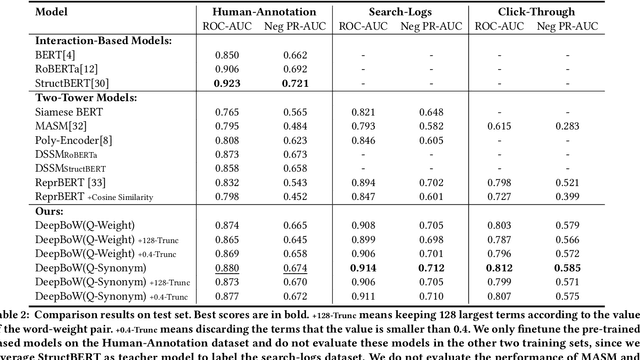

Abstract:Text relevance or text matching of query and product is an essential technique for the e-commerce search system to ensure that the displayed products can match the intent of the query. Many studies focus on improving the performance of the relevance model in search system. Recently, pre-trained language models like BERT have achieved promising performance on the text relevance task. While these models perform well on the offline test dataset, there are still obstacles to deploy the pre-trained language model to the online system as their high latency. The two-tower model is extensively employed in industrial scenarios, owing to its ability to harmonize performance with computational efficiency. Regrettably, such models present an opaque ``black box'' nature, which prevents developers from making special optimizations. In this paper, we raise deep Bag-of-Words (DeepBoW) model, an efficient and interpretable relevance architecture for Chinese e-commerce. Our approach proposes to encode the query and the product into the sparse BoW representation, which is a set of word-weight pairs. The weight means the important or the relevant score between the corresponding word and the raw text. The relevance score is measured by the accumulation of the matched word between the sparse BoW representation of the query and the product. Compared to popular dense distributed representation that usually suffers from the drawback of black-box, the most advantage of the proposed representation model is highly explainable and interventionable, which is a superior advantage to the deployment and operation of online search engines. Moreover, the online efficiency of the proposed model is even better than the most efficient inner product form of dense representation ...
Large Language Model based Long-tail Query Rewriting in Taobao Search
Nov 12, 2023



Abstract:In the realm of e-commerce search, the significance of semantic matching cannot be overstated, as it directly impacts both user experience and company revenue. Along this line, query rewriting, serving as an important technique to bridge the semantic gaps inherent in the semantic matching process, has attached wide attention from the industry and academia. However, existing query rewriting methods often struggle to effectively optimize long-tail queries and alleviate the phenomenon of "few-recall" caused by semantic gap. In this paper, we present BEQUE, a comprehensive framework that Bridges the sEmantic gap for long-tail QUEries. In detail, BEQUE comprises three stages: multi-instruction supervised fine tuning (SFT), offline feedback, and objective alignment. We first construct a rewriting dataset based on rejection sampling and auxiliary tasks mixing to fine-tune our large language model (LLM) in a supervised fashion. Subsequently, with the well-trained LLM, we employ beam search to generate multiple candidate rewrites, and feed them into Taobao offline system to obtain the partial order. Leveraging the partial order of rewrites, we introduce a contrastive learning method to highlight the distinctions between rewrites, and align the model with the Taobao online objectives. Offline experiments prove the effectiveness of our method in bridging semantic gap. Online A/B tests reveal that our method can significantly boost gross merchandise volume (GMV), number of transaction (#Trans) and unique visitor (UV) for long-tail queries. BEQUE has been deployed on Taobao, one of most popular online shopping platforms in China, since October 2023.
Rethinking the Role of Pre-ranking in Large-scale E-Commerce Searching System
May 23, 2023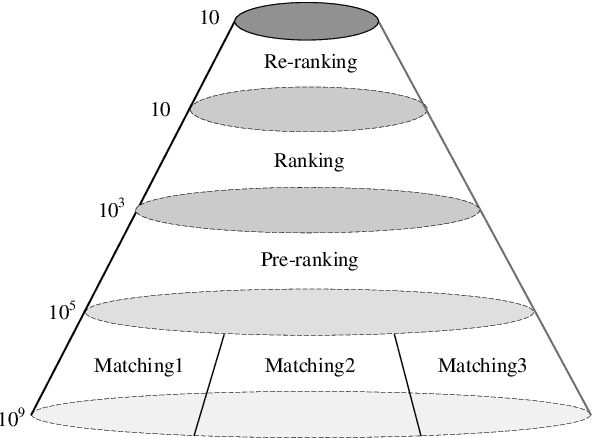

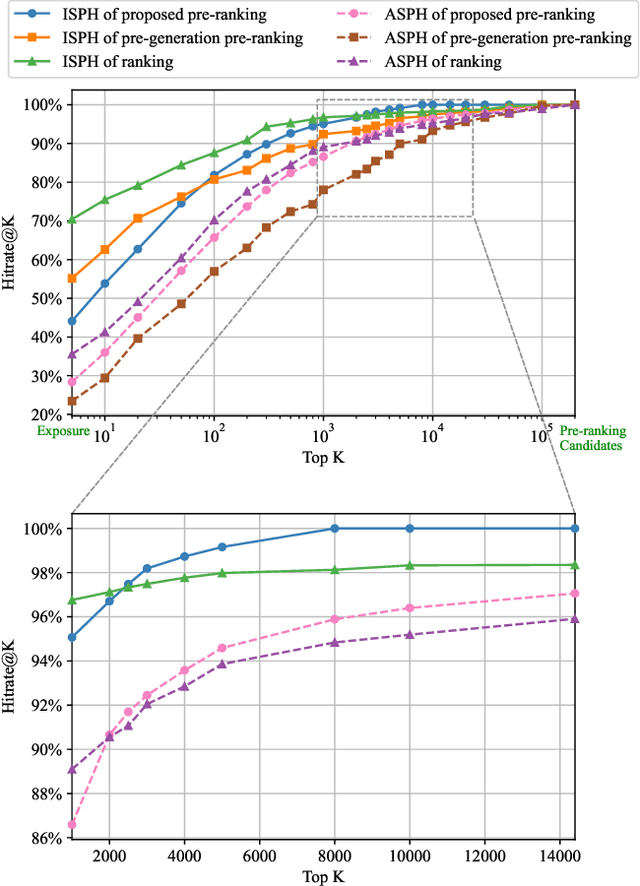
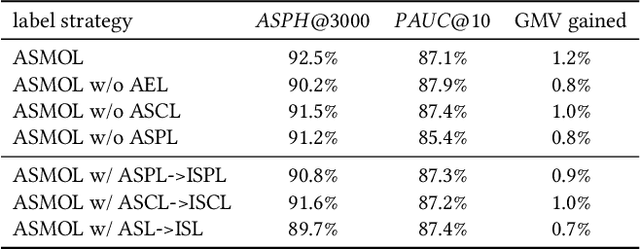
Abstract:E-commerce search systems such as Taobao Search, the largest e-commerce searching system in China, aim at providing users with the most preferred items (e.g., products). Due to the massive data and limited time for response, a typical industrial ranking system consists of three or more modules, including matching, pre-ranking, and ranking. The pre-ranking is widely considered a mini-ranking module, as it needs to rank hundreds of times more items than the ranking under limited latency. Existing researches focus on building a lighter model that imitates the ranking model. As such, the metric of a pre-ranking model follows the ranking model using Area Under ROC (AUC) for offline evaluation. However, such a metric is inconsistent with online A/B tests in practice, so engineers have to perform costly online tests to reach a convincing conclusion. In our work, we rethink the role of the pre-ranking. We argue that the primary goal of the pre-ranking stage is to return an optimal unordered set rather than an ordered list of items because it is the ranking that determines the final exposures. Since AUC measures the quality of an ordered item list, it is not suitable for evaluating the quality of the output unordered set. This paper proposes a new evaluation metric called All-Scenario Hitrate (ASH) for pre-ranking. ASH is proven effective in the offline evaluation and consistent with online A/B tests based on numerous experiments in Taobao Search. We also introduce an all-scenario-based multi-objective learning framework (ASMOL), which improves the ASH significantly. Surprisingly, the new pre-ranking model can outperforms the ranking model when outputting thousands of items. The phenomenon validates that the pre-ranking stage should not imitate the ranking blindly. With the improvements in ASH consistently translating to online improvement, it makes a 1.2% GMV improvement on Taobao Search.
Modeling Users' Contextualized Page-wise Feedback for Click-Through Rate Prediction in E-commerce Search
Mar 29, 2022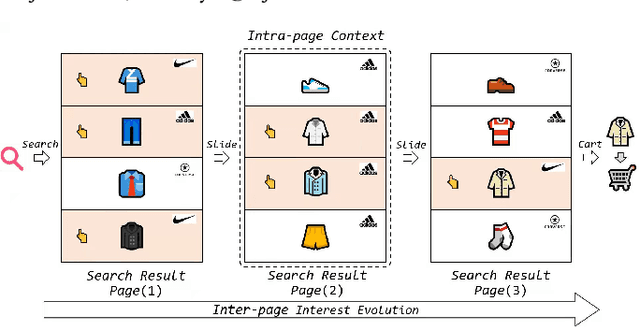

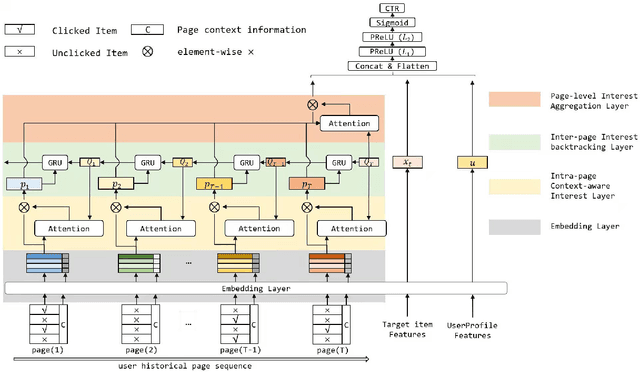

Abstract:Modeling user's historical feedback is essential for Click-Through Rate Prediction in personalized search and recommendation. Existing methods usually only model users' positive feedback information such as click sequences which neglects the context information of the feedback. In this paper, we propose a new perspective for context-aware users' behavior modeling by including the whole page-wisely exposed products and the corresponding feedback as contextualized page-wise feedback sequence. The intra-page context information and inter-page interest evolution can be captured to learn more specific user preference. We design a novel neural ranking model RACP(i.e., Recurrent Attention over Contextualized Page sequence), which utilizes page-context aware attention to model the intra-page context. A recurrent attention process is used to model the cross-page interest convergence evolution as denoising the interest in the previous pages. Experiments on public and real-world industrial datasets verify our model's effectiveness.
 Add to Chrome
Add to Chrome Add to Firefox
Add to Firefox Add to Edge
Add to Edge